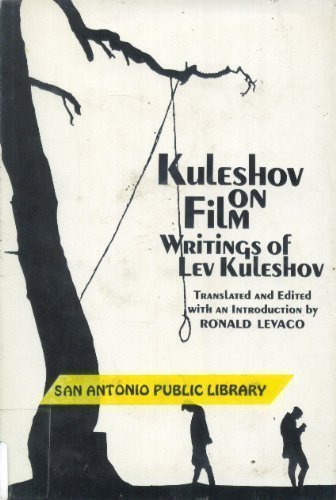Kuleshov on Film: Writings by Lev Kuleshov ebook download
Par stryker howard le lundi, juillet 18 2016, 05:56 - Lien permanent
Kuleshov on Film: Writings by Lev Kuleshov by Lev Vladimirovich Kuleshov, Ronald Levaco


Kuleshov on Film: Writings by Lev Kuleshov Lev Vladimirovich Kuleshov, Ronald Levaco ebook
ISBN: 0520026594, 9780520026599
Format: pdf
Publisher: Univ of California Pr
Page: 121
Eisenstein was a pioneer in the use of montage, a specific use of film editing. Like modern poets who learned their craft writing sonnets, the discipline was good for directors who carried those techniques into the sound era. Although Lev Kuleshov was the first to experiment with Montage, Eisenstein argued that the collision between two adjoining images creates a third meaning. Film language, as it would later be termed, had very little in the way of grammar, most Eisenstein's contemporary soviet theorist, Lev Kuleshov applied this precept to character development. He said editing should make people think, not just see what they see. He and his contemporary, Lev kuleshov, two of the earliest film theorists, argued that montage was the essence of the cinema. Nevertheless, Hitch didn't learn those lessons overnight. -Lev Kuleshov (from "The Principles of Montage" in The Practice of Film Direction, 1935). The Kuleshov effect is a film editing effect demonstrated by the Russian filmmaker Lev Kuleshov in the 1910's and 1920's. Soviet film makers of the 1920s like Kuleshov, Pudovkin, and Sergei Eisenstein all were founding fathers of montage, although it is argued that Eisenstein defined. « newer: The URI to TrackBack this entry is: http://keiran.blogsome.com/2006/09/04/kuleshov-usfilm/trackback/. The following list of a baker's dozen titles, limited to one film per director, is consciously meant to underscore the era's diversity. West in the Land of the Bolsheviks (Kuleshov, 1924). He screened a short film of still images for an audience. The inevitable day eventually comes in film school in which one learns the famed and much-debated Kuleshov Effect. Most film narratives were analogous to silently filmed plays; each scene took place in front of a stationary camera, which was strategically placed to view the entire set, without any cutting or variation.